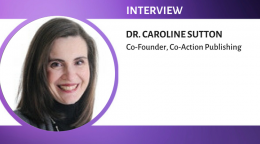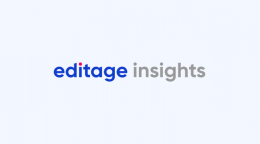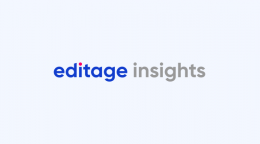Tips for journal editors transitioning to open access and the role of mega-journals in the publishing landscape

Duncan MacRae, Senior Publisher of the journal Medicine published by Wolters Kluwer, played a major role in transitioning the journal from a subscription-based model to an open access publication. Duncan’s primary focus is on introducing efficiencies in journal workflow systems to revitalize editorial operations and implementing new technologies into the editorial workflow. In this interview, Duncan describes the workflow of Medicine and how it transitioned to open access, as well as similarities and differences between open access and subscription-based publishing models. Duncan shares an interesting perspective about mega-journals, which have lesser restrictions and can offer authors help with post-publication promotion. He goes on to share his observations of what authors, publishers, and editors think about open access today.
Let’s talk about the journal Medicine first. What led to the decision to transition Medicine from a subscription-based model to an open access publication? How long did the transition take and how did it impact the journal’s readership/subscriptions?
Medicine had been publishing terrific, high-quality content since 1922. However, the journal did not have the support of a society, and that lack of a built-in base of authors and readers limited its ability to compete with other general medicine journals. At the same time, Wolters Kluwer was looking to produce a broad open access publication, and converting an established title was considered a more attractive option than launching an entirely new title.
The transition from subscription to fully open access took about a year. For about 6 months, we published both types of content as we had a backlog of non-open access content. We also phased out subscriptions during this time, so that subscribers were made aware well ahead of time that the title would no longer be available for purchase, but freely available to all.
How easy or difficult is it for subscription-based journals to transition to open access today? What are the most important things publishers should be mindful of when planning this transition?
Probably, the most important aspect is making sure that the journal is appropriate for open access. If you have a financially successful subscription title with adequate submissions, adopting a hybrid model of open access, rather than completely transitioning to open access, is likely the better move. However, in cases where subscription or advertising revenue is falling, or authors are moving to open access journals at a high rate, then it may be time to consider open access as an option.
The most complex issue for us was in the handling of institutional subscribers; both in alerting them properly of the changes taking place, and planning for them to continue receiving the content via a new method. For example, for an institution that had always received Medicine content as part of a purchased collection, we had to make sure that they understood that Medicine would still be available, but as part of a dedicated open access collection, so that they would avoid paying for open access content.
Can you describe the publication process at your journal? Are there any unique features? What are your review times? And what quality control mechanisms do you employ?
The production process we follow for Medicine, post-acceptance, is really no different than that for any other journal. We perform copyediting, typesetting and proofing, as we would with any other journal. Likewise, review times are competitive with most other journals. Our average time from submission to first decision is around 27 days. The review process is similar to that of a subscription journal, with the overwhelming majority of submissions undergoing multiple revisions prior to acceptance.
There are, however, some unique features of both the review process and the quality control mechanism we employ. Firstly, all 8 Medicine article types are mapped to a specific research-reporting guideline, and we require the completion of applicable checklists and flowcharts with every submission. For example, if someone is submitting a systematic review and meta-analysis, the manuscript must be prepared in accordance with the PRISMA guidelines and include the appropriate support materials. This provides our reviewers and editors with a consistent format and structure for all submissions. It also provides at least a minimum level of quality and thoroughness.
Secondly, our system of assigning editors is entirely based on matching manuscript to editor based on a fairly detailed expertise-based classification scheme. Authors assign up to 5 classifications to their submissions, and editors are asked to select their areas of expertise from the same classification list. The goal is to ensure that editors are only asked to take on submissions that precisely match their interests. We think this is beneficial to the authors, readers, and to the review process in general.
Your professional role, too, has transitioned from managing subscription-only journals to leading a fully open access publication. How different is overseeing an online open access journal from managing a print-only journal? What are the unique challenges associated with an open access journal?
Despite the differences in licensing model, both types of journal are similar to manage, in that the challenge is to create effective workflows and processes. The differences for Medicine are really in the structure and management of the editorial board, which has evolved from a very small group of established experts from a single institution, to an international board of over 750 members. This change has more to do with handling the volume of submissions that Medicine now receives, as opposed to the new open access status.
Does submitting to a multidisciplinary open access journal have distinct advantages over submitting to a subscription-based publication? If yes, what are they?
A multidisciplinary open access journal has enormous freedom to publish content without the financial constraints imposed by the subscription model. For example, since each article published is essentially self-financed, Medicine doesn’t have to concern itself with page count limits. As a result, our time to publication is only governed by the amount of content our production team can handle. Additionally, authors can be assured that the potential of their article is only limited by the terms of the license that they have selected.
The “mega-journal” concept seems to have caught on today. Can you explain the concept a bit for our readers? What role do you think mega-journals play in the publication landscape today and what does the future of open access publication look like to you?
Medicine as a “mega-journal” has been an interesting transition, because it runs counter to so many authors’ ideas about the traditional order of journals. We are not a specialty journal, but 43 specialty journals published under one masthead. Since our editorial mission is to publish all work that is scientifically and ethically valid, without considering novelty or potential for impact, it means we have the freedom to publish negative studies and case reports without concern for the editorial makeup of the journal.
Our most recent developments have all been about making navigation of this wide array of content easier for readers. We publish 20 to 40 articles on any number of topics within a week. The problem we recognized was that if I am a cardiologist, for example, how do I find content of interest to me amongst the hundreds of articles published per month? Our solution has been to create category pages that act as journals within the journal. This probably paints a pretty good picture of the future of open access, as well as the future of the “mega-journal.” Medicine is presented as a “mega-journal” because that works best for indexing and distribution, but it operates editorially as 43 specialty journals. It wouldn’t surprise me if the next phase for the “mega-journal” is the spinning off of these specialty areas based on citation performance.
Let’s talk a bit about open access as a concept and how it has been accepted. Having worked with different user segments – publishers as well as authors – do you see a clear difference in how each of these segments views the open access movement? Is one group more evidently pro-open access?
In my experience, authors are either excited or ambivalent about the possibilities represented by open access publishing. I haven’t run into many authors who are actively against open access publishing. Publishers have certainly shifted their perspective in recent years to see open access as having enormous potential for revenue, but I think the established publishers have also recognized that the reputation of open access publishing needs to be wrestled away from “predatory publishers” in order for them to maximize its potential. Although the motives might be different, both publishers and authors have every incentive for open access publishing to succeed.
I would probably add a third group to the mix, and that is the editors, who have a distinct point of view from publishers and authors. The “mega-journal” model, in particular, does away with the traditional role of an editorial board. In a model that does not emphasize novelty or impact, the concept of an editor crafting a journal’s editorial mission becomes irrelevant, and I can understand that editors might feel threatened. However, what we have seen is open access titles as supplemental to a traditional high-impact journal. For example, a journal with a very selective acceptance rate might develop an open access title to provide an option to authors who have written a manuscript that is worthy of publication, but may not have achieved a level of priority high enough for the flagship publication. This approach addresses a lot of issues, such as losing submissions to your competitor, while maintaining the role and impact of a traditional editorial board.
Thank you, Mr. McRae.
This interview was conducted by Clarinda Cerejo and Jayashree Rajagopalan.
Full disclosure: Editage has collaborated with Wolters Kluwer to release a new website where Wolters Kluwer will offer editorial services and online educational resources to authors submitting manuscripts on healthcare research to its Lippincott Williams & Wilkins (LWW) journal portfolio. However, this interview has been conducted independently by Editage Insights and poses no commercial conflict of interest.
Published on: May 15, 2015
Comments
You're looking to give wings to your academic career and publication journey. We like that!
Why don't we give you complete access! Create a free account and get unlimited access to all resources & a vibrant researcher community.

Subscribe to Journal Selection
After writing a research paper, the next step is to find the right journal to publish it. Subscribe and get curated content to find the perfect journal that will give impetus to your research paper and your career.






